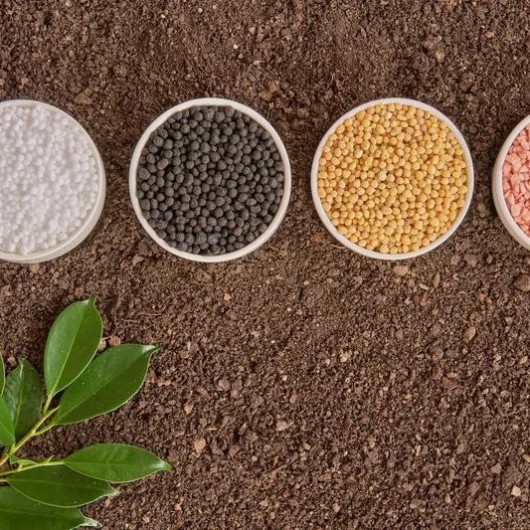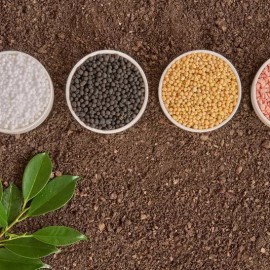Compound:
Amide nitrogen - 9%
Magnesium - 3%
Organic polymers - 10%
Main functions preparation – foliar feeding of growing plants, correction of nitrogen nutrition of plants, increase in yield and quality of products.
It is possible to use the preparation in drip irrigation.
Mechanism of Action:
Nitrogen is one of the three macronutrients that plants consume. Nitrogen is the main key component of all plant amino acids. It is found in any part of the plant, participates in the synthesis of chlorophyll, and is a component of auxins.
Magnesium - an important element of photosynthesis, activates photosynthesis and accompanying biochemical reactions. Magnesium is part of the chlorophyll molecule and is directly involved in photosynthesis. It participates in the movement of phosphorus in plants, activates enzymes, accelerates the formation of carbohydrates. Magnesium is also a building block of cells, being part of ribosomes.
This is a necessary microelement for activating nitrogen metabolism. Thanks to magnesium fertilizing, photosynthesis is maximally activated and the potential of nitrogen fertilizers is fully realized.
Efecto nitrogen contains nitrogen in amide form. Amide form of nitrogen is ideal for foliar treatments, molecules of amide form of nitrogen easily penetrate into leaf blade without breaking down into ions, acting even at low temperatures. Amide form of nitrogen does not cause leaf burn in case of overdose or high temperatures.
Organic polymers : due to their multifunctionality, they significantly increase the coefficient of nitrogen use by the plant, and also help to enhance the biochemical reactions that accompany nitrogen absorption.
The main functions of organic polymers and their components:
- The organic polymer has the properties of a surfactant and partially the properties of an adhesive, which significantly improves the quality of foliar treatments, increases their efficiency and reduces nitrogen losses during treatments.
Organic polymer is a good solution dispersant and helps stabilize multi-component tank mixtures.
- Polycarboxylic acids, included in the organic polymer, increase the efficiency of nitrogen penetration into the plant and enhance the biological activity of the processes of nitrogen assimilation by the plant.
- Reducing agents , which are part of the organic polymer, have an antioxidant effect and increase the resistance of plants to stress factors.
- Soluble form of lignin, which is part of the organic polymer, helps to saturate the plant with an easily accessible form of lignin, which is used in the process of plant formation, increases the strength of the stems, and participates in the formation of vascular bundles. It has a positive effect on the water balance of the plant and the movement of nutrients.
Directions for use:
CONSUMPTION RATES OF THE PREPARATION "EFEKTO-NITROGEN" AND THE TIME OF PROCESSING GRAIN CROPS
| CULTURE | PROCESSING TIME | CONSUMPTION RATE OF THE PRODUCT "EFECTO-NITROGEN" | AMOUNT OF SOLUTION REQUIRED FOR TREATMENT |
| WINTER GRAIN CROPS | Spraying plants during the tillering phase | 1-2 l/ha | 300 l of solution per 1 ha |
| The first spraying of plants in spring after the resumption of vegetation | 2 l/ha | 300 l of solution per 1 ha | |
| Processing in the flag leaf phase | 1-2 l/ha | 300 l of solution per 1 ha | |
| SPRING CEREALS CULTURES | First spraying in the tillering phase | 1-2 l/ha | 300 l of solution per 1 ha |
| Processing in the flag leaf phase | 1-2 l/ha | 300 l of solution per 1 ha | |
| BUCKWHEAT | The first spraying of plants at the beginning of branching. | 1 l/ha | 300 l of solution per 1 ha |
| Second treatment in the budding phase | 1 l/ha | 300 l of solution per 1 ha |
CONSUMPTION RATES OF THE PREPARATION "EFEKTO-NITROGEN" AND THE TIME OF PROCESSING TECHNICAL CROPS
| CULTURE | PROCESSING TIME | CONSUMPTION RATE OF THE PRODUCT "EFECTO-NITROGEN" | AMOUNT OF SOLUTION REQUIRED FOR TREATMENT |
| SUNFLOWER | Spraying plants when they appear 2-5 true leaves | 1-2 l/ha | 300 l of solution per 1 ha |
| Spraying in the “Star” phase | 1-2 l/ha | 300 l of solution per 1 ha | |
| CORN | The first spraying of plants when 3-4 true leaves appear | 2 l/ha | 300 l of solution per 1 ha |
| Treatment in the phase of 7-10 leaves | 2-3 l/ha | 300 l of solution per 1 ha | |
| SUGAR BEET | The first spraying of plants when 2-3 true leaves appear | 1 l/ha | 300 l of solution per 1 ha |
| Second treatment in the phase before rows close | 2-3 l/ha | 300 l of solution per 1 ha |
CONSUMPTION RATES OF THE PRODUCT "EFECTO-NITROGEN"
AND TIMES OF PROCESSING LEGUM CROPS
| CULTURE | PROCESSING TIME | CONSUMPTION RATE OF THE PRODUCT "EFECTO-NITROGEN" | AMOUNT OF SOLUTION REQUIRED FOR TREATMENT |
| SOY | Spraying plants when they appear 2-3 trifoliate leaves | 1 l/ha | 300 l of solution per 1 ha |
| Spraying at the beginning of budding phase | 1 l/ha | 300 l of solution per 1 ha | |
| PEAS | The first spraying of plants when 2-3 leaves appear | 1 l/ha | 300 l of solution per 1 ha |
| Processing at the beginning of budding phase | 1 l/ha | 300 l of solution per 1 ha | |
| NUT | The first spraying of plants when 2-3 true leaves appear | 1 l/ha | 300 l of solution per 1 ha |
| Second treatment at the beginning of budding phase | 1 l/ha | 300 l of solution per 1 ha |
CONSUMPTION RATES OF THE PREPARATION "EFEKTO-NITROGEN" AND THE TIME OF PROCESSING POTATOES AND VEGETABLE CROPS
| CULTURE | PROCESSING TIME | CONSUMPTION RATE OF THE PRODUCT "EFECTO-NITROGEN" | AMOUNT OF SOLUTION REQUIRED FOR TREATMENT |
| POTATO | First spraying of plants when seedlings appear | 1-2 l/ha | 300 l of solution per 1 ha |
| Second and subsequent treatments at intervals of 20 days until the end of flowering | 1-2 l/ha | 300 l of solution per 1 ha | |
| BEET DINING ROOM | The first spraying of plants when they appear 2-3 true leaves | 1 l/ha | 300 l of solution per 1 ha |
| Second and subsequent treatments at intervals 20 days | 1-2 l/ha | 300 l of solution per 1 ha | |
| CARROT | The first spraying of plants when 2-3 true leaves appear | 1-2 l/ha | 300 l of solution per 1 ha |
| Second and subsequent treatments at intervals 20 days | 1-2 l/ha | 300 l of solution per 1 ha | |
| CUCUMBERS OPEN AND PROTECTED SOIL | The first spraying of plants when 2-3 true leaves appear in the case of non-seedling cultivation or immediately after planting seedlings in the ground | 1-2 l/ha | 300 l of solution per 1 ha |
| Second and subsequent treatments at intervals 20 days | 1-2 l/ha | 300 l of solution per 1 ha |
CONSUMPTION RATES OF THE PREPARATION "EFEKTO-NITROGEN" AND THE TIME OF PROCESSING VEGETABLE CROPS
| CULTURE | PROCESSING TIME | CONSUMPTION RATE OF THE PRODUCT "EFECTO-NITROGEN" | AMOUNT OF SOLUTION REQUIRED FOR TREATMENT |
| TOMATOES OF OPEN AND PROTECTED GROUND | The first spraying of plants the appearance of 2-3 true leaves without seedlings or immediately after planting seedlings in the ground | 1 l/ha | 300 l of solution per 1 ha |
| Second and subsequent treatments at intervals of 20 days | 2-3 l/ha | 300 l of solution per 1 ha | |
| PEPPER | First spraying of plants immediately after planting the seedlings | 1-2 l/ha | 300 l of solution per 1 ha |
| Second and subsequent treatments at intervals of 20 days | 2-3 l/ha | 300 l of solution per 1 ha | |
| EGGPLANT | First spraying of plants immediately after planting the seedlings | 1 l/ha | 300 l of solution per 1 ha |
| Second and subsequent treatments at intervals of 20 days | 2-3 l/ha | 300 l of solution per 1 ha |
CONSUMPTION RATES OF THE PRODUCT "EFECTO-NITROGEN"
AND TIMING OF PROCESSING VEGETABLE CROPS
| CULTURE | PROCESSING TIME | CONSUMPTION RATE OF THE PRODUCT "EFECTO-NITROGEN" | AMOUNT OF SOLUTION REQUIRED FOR TREATMENT |
| CABBAGE | First spraying of plants immediately after planting the seedlings | 1 l/ha | 300 l of solution per 1 ha |
| Second and subsequent treatments at intervals of 20 days | 1-2 l/ha | 300 l of solution per 1 ha | |
| CELERY | Spraying plants immediately after planting the seedlings | 1 l/ha | 300 l of solution per 1 ha |
| SALAD HEAD LETTUCE DILL PARSLEY | Spraying plants during the germination phase | 1 l/ha | 300 l of solution per 1 ha |
Tags: Efecto Nitrogen


